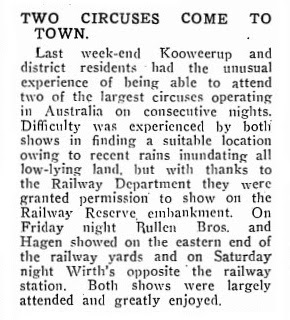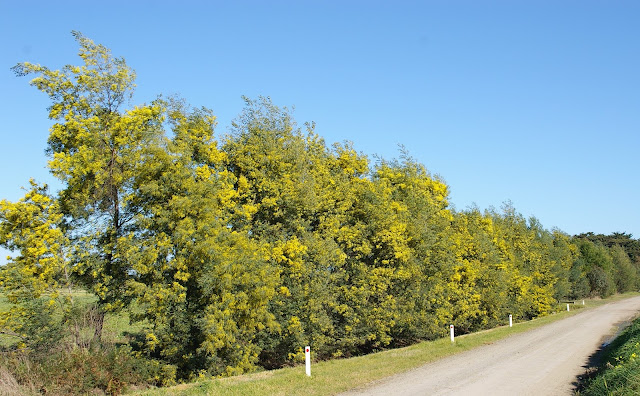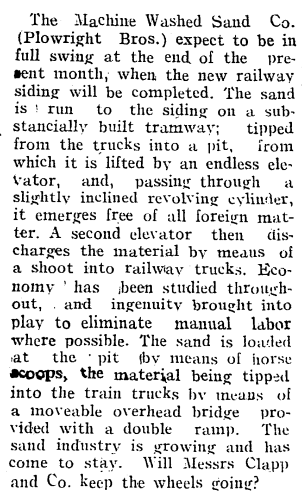Rossiter Road is named after Charles Rossiter. Charles and Ellen Rossiter took up 317 acres of land at Yallock in 1873 (1) and named the property Hawkesdale. It was located at Lot 10b, Parish of Yallock and situated between Koo Wee Rup and Bayles, near Bethune's Road. Before this Charles and Ellen lived at Ravenhurst (later called Gladys Park and Tulliallan) on Clyde Road, south of Grices Road in Cranbourne North; I have written about this property here.
Charles and Ellen Rossiter, early 1890s.
Photographer: Yeoman & Co.
State Library of Victoria Image H82.96/39
Dr Niel Gunson, in The Good Country: Cranbourne Shire (2) explains the complicated ownership of the Ravenhurst property - Ravenhurst was part of the Garem Gam Run of 3,200 acres (1300 hectares) taken up by James Bathe and T.J Perry in 1837. In 1845, Garem Gam was subdivided and the eastern part was called Ravenhurst. Ravenhurst was held by John Crewe until his death in 1850 and was then taken up by Benjamin Rossiter (Charles’ father) and Maurice Feehan. In 1851 it appears that the property (Garem Gam) was leased as a whole by Benjamin Rossiter, Maurice Feehan and Sarah O’Shea. By 1854, Benjamin Rossiter had the entire property Sarah O'Shea had been leasing the other section of the Garem Gam property with John Crewe (3). Crewe had also acquired the Mayune from Frederick Ruffy in 1850 just before he (Crewe) died in 1850 at the age of 31. Crewe’s widow Eliza then took over the lease of Mayune until the property which was then acquired by Alexander Cameron in 1851 (4). I have written about Mayune and John Crewe, here.
Benjamin Rossiter (1786 - 1858) and his wife Zillah Baynton (1789 - 1871) had arrived in the Western Port area in 1842, having come out from Somersetshire in 1842 (5). Benjamin Rossiter died in 1858 and his sons Charles and Thomas, took over the property. As well as the two boys Benjamin and Zillah had two daughters - Ann who died as a teenager and Mercy who married Henry Wedge. Henry Wedge and his bothers Charles and John had the Bangam and Ballymarang Stations (6). Bangam was located between the Dandenong and Eumemmerring Creeks (modern day Doveton) and Ballamarang, which is around modern day Carrum Downs and across to Seaford and Port Phillip Bay. Wedge Road in Carrum Downs is named for the family. Mercy Wedge died in 1903 aged 80. Thomas James Rossiter, who died in Molong, New South Wales in 1908, married Mary Ann O’Shea in 1854, the same year his brother, Charles, married Ellen O’Shea. Mary Ann and Ellen were sisters, the daughters of John O’Shea (died 1852 aged 51) and his first wife, Mary Josephine Ryan. The Sarah O'Shea mentioned before is believed to be John
O'Shea's second wife. O’Shea’s Road is named for the family (7).
The aforementioned Eliza Crewe died in 1868 at the age of 44. She was the daughter of Thomas Baynton and Eliza Arabella Smith. Thomas Baynton was the brother of Zillah Baynton who was married to Benjamin Rossiter, who took over the Ravenhurst property from Crewe after his death. You may wonder was this to help out their niece, Eliza Crewe, or they just knew the area and wanted to settle here. A bit more on Thomas Baynton - he had the Darlington Run near Kyneton in 1841. Baynton the town near Kyneton is named after him (8). Totally irrelevant to this story but an interesting fact is that the Bourke and Wills Exhibition passed by the Baynton property on its way north - Ludwig Becker sketched the occasion (see below).
Crossing an ancient crater from near Dr. Baynton's 25 August 1860. Artist: Ludwig Becker.
State Library of Victoria Image H16486
Charles and Ellen Rossiter had eight children - Edwin Augustus (1856 - 1939, married Ellen Louisa Craig in 1890), Emily Baynton (1857 - 1883), Helena Ellen Teresa (1859 - 1902), Charles Benjamin (1865 - 1942, married his first cousin Zillah Rossiter in 1899), Hubert (1869 - 1870), Ellen Teresa (known as Nellie, 1871- 1926 married William Brierley in 1906), Norton Baynton (c. 1875 - 1947, married Hilda Hodgson in 1906) and Claude Cecil (c. 1878 - 1947, married Stella Mary Paragreen in 1907). Charles died on February 6, 1895 aged 74 and Ellen died June 3, 1909 aged 73. They are both buried at the Cranbourne Cemetery
(9).
Death notice of Charles Rossiter.

Claude, Nellie and Norton Rossiter at Hawkesdale, early 1880s
State Library of Victoria Image H82.96/17
What do we know about their life in Koo Wee Rup? Once again we turn to Dr Gunson's book, The Good Country: Cranbourne Shire - Rossiter’s property Hawkesdale was regarded as a show place in the district and the homestead was set off by a profusion of flowers – geraniums, dahlias, rhododendrons, roses, broom and cactus. Besides bloodstock and a shorthorn dairy herd, Rossiter applied intense cultivation - 'in a paddock on the east side of the homestead seventeen successive crops have been grown and for the last fourteen years without manure - the present crop will yield 2 ½ tons of hay to the acre'.

The Rossiters at Hawkesdale, early 1890s. Photographer: Sydney Herbert Edwards.
The photo shows Charles on the left, seated are Ellen and one of the daughters, possibly Nellie. Son Charles is at the back and Norton is lying on the ground.
State Library of Victoria Image H82.96/88
Charles was an original Committee member of the Mornington Farmers Society from 1856, a Cranbourne Shire Councillor from 1869 to 1884 and Shire President on four occasions. Charles and his brother, Thomas, bred horses, amongst their other agricultural pursuits. As he had many children, Charles was interested in having a school established in the area and was one of the local land owners to sign a petition for its establishment. Subsequently, Yallock State School No. 2629 (later called Koo Wee Rup State School) was opened on November 1, 1884 at Bethune's Road (10).

Hawkesdale, Koo Wee Rup, 1890s.
Photo shows Norton, Claude, Nellie, Charles and their cousin, Zillah. Charles and Zillah married in 1899.
I presume this is the building described as 'the dairy, meat room and buggy rooms' in the sale advertisement, below.
State Library of Victoria Image H82.96/45
The Hawkesdale property was put up for auction in November 1898, by Charles’ executors. It was described at the time as being only two miles from the Koo Wee Rup Railway Station. There was a good four roomed brick house, kitchen and kitchen bedroom, two pantries, a large building 70 x 30, comprising dairy, meat room and 2 buggy rooms, storeroom, man's rooms, stable, tool-house, &c; large 10 stalled cow-shed, and calf-room. with hay-room in front; refrigeration room, pig-houses, &c. Good orchard. There was a State School and creamery adjoining the property and it was one of the finest dairy farms in the district.
The sale of Hawkesdale.
AcknowledgmentWe are fortunate that a member of the Rossiter family donated some family photos to the State Library, so we can get a snap shot of their life at
Hawkesdale and other properties. The photos were given by Mrs Leila Trickey (1908 - 1985) the daughter of Claude Rossiter.
Footnotes(1) Gunson, Niel
The Good Country: Cranbourne Shire (Cheshire, 1968) p. 52 Cranbourne Shire Rate Books.
(2) Gunson, Niel
The Good Country: Cranbourne Shire (Cheshire, 1968)
(3) Gunson, op.cit., p. 36
(4) Gunson, op.cit., p. 52
(5) Ibid
(6) Gunson, op. cit., p. 34
(7) Family information - Gunson, op. cit., p. 52; Indexes to Victorian Births, Deaths and Marriages; Obituary of Thomas Rossiter in the
Molong Express, of January 4, 1908, see
here; Personal notices in the newspapers. I had some trouble confirming the relationship between Mary and Ellen O'Shea and John O'Shea, but a comment left on my original post about the Rossiters on my work blog,
Casey Cardinia Links to our Past, by G. Sibbald explains it -
I am a descendant of Charles and Ellen Rossiter. Mary Ann Josephine O'Shea and and Ellen Teressa O'Shea are indeed sisters. Sarah O'Shea was not their mother. Their mother's name was Mary Josephine Ryan. I believe that Sarah O'Shea nee Fitzgerald was John O'Shea's second wife. Mary Ann and Ellen's brothers John and George died in Victoria in 1848 and 1852 respectively. John and Sarah had sons David and Edward, half brothers of the above, who were born in Victoria. (8) Indexes to the Victorian Births, Deaths and Marriages; Personal notices in the newspapers;
Pastoral Pioneers of Port Phillip by R. V. Billis and A.S. Kenyon (Stockland Press, 1974). Thomas Baynton's son, also called Thomas, was married to the writer, Barbara Baynton - see his short obituary in the
Geelong Advertiser, June 14, 1904,
here; and her Australian Dictionary of Biography entry, here
https://adb.anu.edu.au/biography/baynton-barbara-jane-5162(9) Early Settlers of the Casey Cardinia Region (Narre Warren & District Family History Group, 2010) Indexes to Victorian Births, Deaths and Marriages
(10) Gunson, op. cit., p. 111, p. 242 footnote 36. Dr Gunson is quoting the Mornington County Herald, December 4, 1891
(11) Gunson, op. cit., pp 180, 260, 162.













































